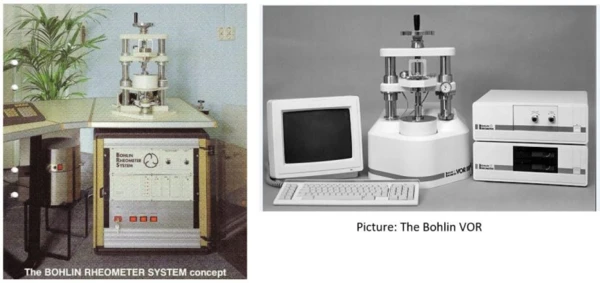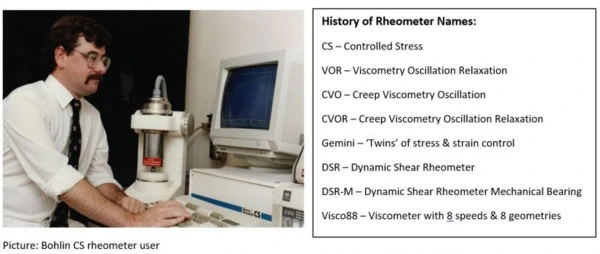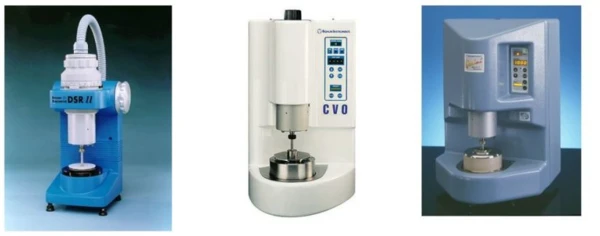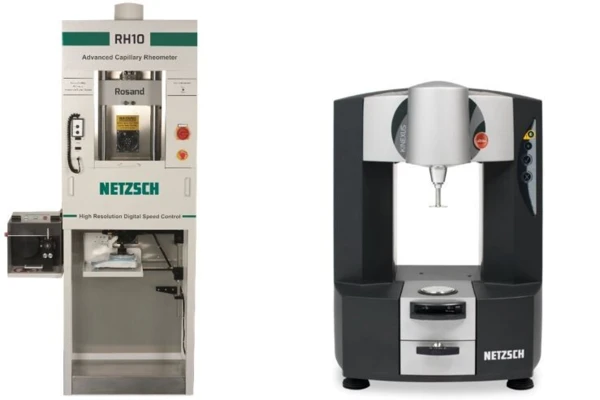
07.06.2022 by Aileen Sammler
60 years of NETZSCH-Geraetebau: The Origins of Rheometry and its Flow Through Time
We continue celebrating 60 years of NETZSCH Analyzing & Testing. June is all about rheology!
Recently, in 2020, NETZSCH acquired the Rheometry Product Line from Malvern Panalytical. In February 2020, NETZSCH was delighted to announce that the Kinexus range of rotational rheometers and the Rosand line of capillary rheometers have become a recent addition to the product portfolio of the Analyzing & Testing business unit. Learn today about the origins of rheometry and where it all started in the 1980s.
Where it all started: The Birth of Bohlin Rheometers and a few of the “Firsts”
Leif Bohlin, a professor of Physics at the University of Lund in Sweden, built simple instruments, mostly in order to perform his own testing on foods & doughs. He started making rheometers for his friends in research when Leif's wife, Gertrud Elisabeth, saw an opportunity to start a new company called Bohlin Reologi. The company was situated at the University in its start-up incubator area.

Bohlin was the first to report rheometer temperature to 0.1°C in 1987!

In 1985, Bohlin established a distribution agreement with a New York company called Pen Chem. Sean Race from Pen Chem managed the Bohlin product which was limited to the VOR Rheometer (Viscometry, Oscillation and RelaxationWhen a constant strain is applied to a rubber compound, the force necessary to maintain that strain is not constant but decreases with time; this behavior is known as stress relaxation. The process responsible for stress relaxation can be physical or chemical, and under normal conditions, both will occur at the same time. Relaxation) at the time. After a successful year, Sean approached Bohlin to take the product direct to market with a team of experienced individuals.
The CS Rheometer was the first to implement auto StressStress is defined as a level of force applied on a sample with a well-defined cross section. (Stress = force/area). Samples having a circular or rectangular cross section can be compressed or stretched. Elastic materials like rubber can be stretched up to 5 to 10 times their original length.stress and StrainStrain describes a deformation of a material, which is loaded mechanically by an external force or stress. Rubber compounds show creep properties, if a static load is applied.strain control in a StressStress is defined as a level of force applied on a sample with a well-defined cross section. (Stress = force/area). Samples having a circular or rectangular cross section can be compressed or stretched. Elastic materials like rubber can be stretched up to 5 to 10 times their original length.stress rheometer.
The first rheometer to report temperature to 0.01°C in 1996!

The Developing Design: Rotational Rheometers and the Beginnings of the Dynamic Shear Rheometer (DSR)
The very first CS (Controlled StressStress is defined as a level of force applied on a sample with a well-defined cross section. (Stress = force/area). Samples having a circular or rectangular cross section can be compressed or stretched. Elastic materials like rubber can be stretched up to 5 to 10 times their original length.Stress) was simply called the CS Rheometer back in 1989-90 when it was released. In 1992 the DSR was also released, designed for a market (asphalt and bitumen binders) that did not require low end sensitivity.

The first asphalt specific Dynamic Shear Rheometer (DSR) was released with dedicated software for characterization and product acceptance in 1991
In 1993 a budget DSR was created by replacing the air bearing with ball bearings, thereby releasing the competitive and popular DSR-M. This system was very popular for those new companies that were scaling up their testing.
The CVO (CreepCreep describes a time and temperature dependent plastic deformation under a constant force. When a constant force is applied to a rubber compound, the initial deformation obtained due to the application of the force is not fixed. The deformation will increase with time.Creep Viscometry Oscillation) was developed in 1992-4 as a 10mNm instrument. By 1996 the CVO-50 was introduced and soon thereafter its motor was implemented into the first DSR-50 in support of the collaboration on the NCHRP 9-10 research project.
The Gemini followed, which integrated the Peltier electronics system from the CVO line and was ultimately specified with an upper 200mNm capability.
In 2000, Bohlin acquired Rosand Precision Instruments (including capillary rheometers), released the DSR-2 before selling to Malvern Instruments in 2003. After the acquisition, the Bohlin line was discontinued in replacement for the Kinexus series of instruments. Completely redesigned, it incorporated all the features that were loved by customers, whilst integrating modularity, flexibility, ease of use and a new intelligent software platform. It remained at Malvern until the 2020 acquisition of the rheology products by NETZSCH.

Kinexus (right) was the first to implement truly interchangeable environmental chambers and geometries not requiring mechanical alignment with Kinexus in 2008.
Read more about the recent development next week! :-)